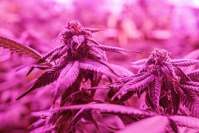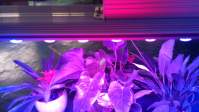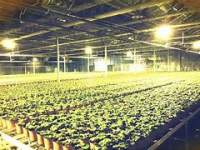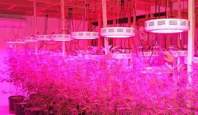Now growers will choose to use LED plant lights to fill light. Because the growth of plants can be affected by the control and adjustment of LED plant lights to achieve the effect that growers want, LED plant lights are one of the most important conditions in tissue culture lighting, mainly from light quality, light intensity, light cycle, etc. aspect:
Light quality
The light quality of LED plants lights has a significant effect on the induction of callus, the proliferation of cultured tissues and the differentiation of organs. Like lily bulbs, cultured under red light, the callus differentiated after 8 weeks. The callus will appear only after several weeks of culture under blue light.
15 days after inoculation with gladiolus bulbs, shoots were cultivated under blue light, and the formed seedlings grew vigorously, and the seedlings were slender under white light. The light quality of LED plants lights also has a certain impact on the growth of tissue cultured seedlings. Studies like carnations show that different wavelengths of light play different roles in tissue culture. Blue light helps induce the production of lateral buds and increase protein content. Red light can promote the growth and neat growth of buds.
White light is beneficial to the growth and development of tissue cultured seedlings, with the highest biological yield, followed by red light; blue light promotes the increase of reducing sugar content in stems and leaves, but has little effect on total sugar; white light can also increase the synthesis of chlorophyll. Fan Cihui et al. found that gladiolus globules emerge earlier under blue light than under white light and red light, the seedlings grow vigorously, and the root system is strong; the seedlings are slender under white light, and the number of seedlings under red light is small.
Red light induced callus induction and growth of lily and mung bean better than self-light. If you can consciously apply these LED plant light quality effects to the large-scale production of seedlings, you can achieve the purpose of energy saving and increase production.
Light intensity
Tissue culture LED plant light intensity has an important impact on cell proliferation and organ differentiation. From the current research situation, light intensity has a significant effect on cells and the initial division of cells. , The light is strong, the seedlings grow stout, and the light is weak, the seedlings grow easily. In plant tissue culture, external carbon sources are mainly used as energy sources, and light is mainly used to meet the needs of plant morphology.
The light intensity of LED plant light of 300~500lx can be guaranteed, but for most flowers, 2000~3000 1x is more suitable. In the rooting stage, in order to make the rooting seedlings grow strong and adapt to the field environment as soon as possible, it is necessary to appropriately increase the intensity of the LED plant light to 3000~5000lx, or even 10000lx. If a higher concentration of CO2 is added, the photosynthesis of the seedlings can be enhanced, forcing them to change from heterotrophic to autotrophic, so that the tissue cultured seedlings can grow more robustly.
In order to save costs, in the construction and design of the tissue culture room, you can consider making full use of daylight. "Rooms with better lighting are used as cultivation rooms, and rooms with poor or dark light are used as reagent rooms and cultivation rooms. Some people use greenhouses as cultivation rooms and have also achieved better cultivation results. Using natural light as a light source can reduce Cost of production.
At the same time, since natural light is generally stronger than fluorescent lamps, the cultivated seedlings are relatively short, although the plants grow under strong light. It is relatively slow and slightly green, but due to the accumulation of carbohydrates, the tissue is full and it is easy to adapt to the external environment, and the teleportation survival rate is high.
If it is only beneficial to natural light, it will be greatly affected by the weather. On the one hand, the number of layers and columns in the room and floor are not evenly exposed to light. On the other hand, in clear and cloudless weather, excessive sunlight can burn the seedlings and even die. It is necessary to use thin curtains for proper shading; but under continuous rainy conditions and insufficient light, the seedlings will be weak and long. Fluorescent lights must be installed on all cultivation racks. It needs to be flexibly adjusted to the prevailing weather conditions.
Light period
When the test-tube shoots are cultured in vitro, a certain light-dark cycle is used for tissue culture. The most commonly used time periods are 16 hours bright and 8 hours dark. Studies have shown that organs and tissues of varieties that are sensitive to short sunlight are prone to differentiation under short sunlight. Callus produced under long sunlight sometimes needs to be cultured in the dark, especially the callus of some plants is darker. Light.
Okay, like callus of safflower and black ash. For most plants, 14-16 hours of LED plant light illumination and 8-10 hours of darkness can meet the needs of growth and development. However, different plants and different cultivation purposes sometimes have certain differences. The 12h LED plant light cycle is suitable for chrysanthemum tuber seedlings. Geranium bulimia callus induces bud formation, 15-16h light produces the most buds. If 24h light, the callus cannot turn green and can not produce buds; under 16-18h light, morning glory stem meristem can grow The formation of small plant wipes does not require light all day; under 16h light and long-term darkness, the taro leaves are cut into leaves and seedlings.
In addition, the LED plant light cycle also has a significant impact on the formation and induction of flower buds. Some plants need dark culture during the callus induction period, and light during the differentiation bud stage, such as gladiolus; carnations need dark culture a few days before the cultivation, and then transfer to normal culture, which is conducive to the occurrence of callus; some photosensitive varieties Flower bud differentiation can be induced under light conditions and time.
Advantages of LED plant lights in tissue culture
1. It can be well used in tissue culture, and can be illuminated at close range to provide sufficient light to plants;
2. The wavelength can be customized, which can replace high-pressure sodium lamps, halogen lamps, and fluorescent lamps with 3-5 times the power, saving 80% of electric energy;
3. Long service life, up to 50,000 hours;
4. The ratio of lamp beads can be freely matched to meet the needs of different plants and different growth stages;
5. It can control the growth rate of plants and predict the maturity time of the market;
6. LED plant light is a kind of energy-saving, environmentally friendly and efficient plant growth light.
7. The heat emitted is much lower than traditional plant growth lamps.
8. No standard power socket connectors for drivers or cooling fans are required.
9. Promote early maturity of plants, increase production, and improve the quality of melons and fruits;
10. Ensure the taste of vegetables in greenhouses and realize off-season cultivation;
11. Inhibit the reproduction of germs and pests, and make it green without pollution.
An innovative cultivation method in tissue culture, LED plant lights are also the trend of indoor planting and supplementary light demand. With the continuous progress and development of technology, the two will definitely be perfectly combined to bring better results.






